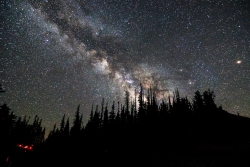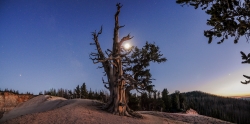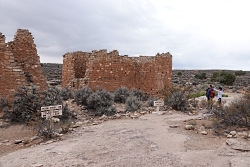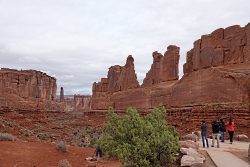
Courtesy US NPS, Zach Schierl, Photographer
These types of experiences may also occur after dark when visitors participate in stargazing or a full-moon hikes.

Courtesy US NPS, Zach Schierl, Photographer
Protecting the quiet and darkness of our National Parks has become a priority for many managers and researchers.

Courtesy US NPS, Zach Schierl, Photographer
title=”Four planets and the Moon are visible in the twilight sky over ancient Bristlecone Pine trees at Cedar Breaks NM Courtesy US NPS, Zach Schierl, Photographer”

Courtesy US NPS, Zach Schierl, Photographer
The book gathered many interesting findings.

Courtesy & Copyright Shauna Leavitt
As noise increases the listening area may decrease dramatically.
Monz said, “In the United States noise from roads has increased three fold since 1970.”
A three decibel increase in noise results in a 50 percent decrease in listening area. If there is a 10 decibel increase, the result is a staggering 90 percent decrease in listening area.
Monz explains, “If you put noise into the environment there is the potential for significant ecological implications, particularly for wildlife. They can no longer be reliant on the sense of hearing to carry out normal activities…some species will move out of those noisy areas to quieter environments which creates a displacement effect.”
For humans, this means we have less opportunities to engage with the sights and sounds of nature.
One success story outlined in the book occurred in Muir Woods National Monument in California. Monz said, “Simply by putting up signs which raised the visitor’s awareness of the environment they were in, and the importance of quiet for other visitors, the noise decreased by 2 decibels. This gave folks an opportunity to experience better natural quiet environment and a little bit more biodiversity from the standpoint of hearing bird calls from the surrounding forest.”
The book also provides ideas for managing the resource of darkness in the National parks.

Courtesy & Copyright Shauna Leavitt
Cedar Breaks National Monument, which has the highest star gazing site at 10,500 feet, received an award from The International-Dark Sky Association (IDA) for preserving its Dark skies.
The authors of “Natural Quiet and Natural Darkness” hope the book will get in the right hands to provide park managers with this easily accessible tool where they can find the best science and actionable ideas to increase quiet and darkness in our National Parks.
This is Shauna Leavitt and I’m Wild About Utah.
Natural Quiet and Darkness in our National Parks-Credits:
Photos:
Courtesy US NPS, Zach Schierl, Photographer, Education Specialist, Cedar Breaks National Monument
Courtesy & Copyright Shauna Leavitt,
Audio: Courtesy and Copyright
Text: Shauna Leavitt, Utah Cooperative Fish and Wildlife Research Unit, Quinney College of Natural Resources, Utah State University
Natural Quiet and Darkness in our National Parks-Additional Reading
Experience Dark Night Skies, Cedar Breaks National Monument, US National Park Service, https://www.nps.gov/cebr/planyourvisit/experience-dark-night-skies.htm
Cedar Breaks National Monument Designated as an International Dark Sky Park, https://www.nps.gov/cebr/learn/news/cedar-breaks-national-monument-designated-as-an-international-dark-sky-park.htm
Burkitt, Bree, Cedar Breaks recognized as Dark Sky Park, The Spectrum, https://www.thespectrum.com/story/news/local/cedar-city/2017/03/09/cedar-breaks-recognized-dark-sky-park/98980850/
Spotlight – The Cedar Breaks National Monument Master Astronomer Program, Colorado Plateau Dark Sky Cooperative, https://cpdarkskies.org/2018/10/17/spotlight-the-cedar-breaks-national-monument-master-astronomer-program/
Experience the Magic of the Stars at Utah’s State Parks, Utah State Parks Blog, State of Utah, April 13, 2023, https://stateparks.utah.gov/2023/04/13/experience-the-magic-of-the-stars-at-utahs-state-parks/
